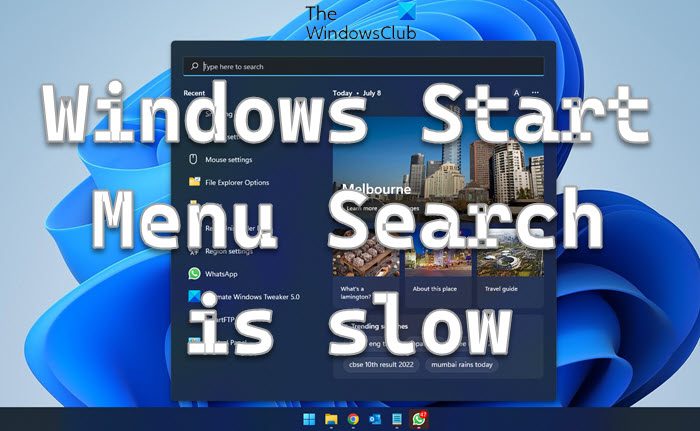Why is the Start menu so slow?
The Start Menu can search slow because of various reasons. Usually, it can nothing but a glitch that is resolved by some restarts. If it’s the File Explorer, then just restart it, if it’s the search service, restart it, since we don’t know what actually is the cause, we are going to restart all of them. If that doesn’t work, then the reason will be the fact that you are putting too much load on Start Menu. Web search and indexing of every single file type can put a lot of load on the Start Menu.
Start Menu Search is slow in Windows 11/10
If the Start Menu Search bar is slow to open or if the Search operation itself is slow in Windows 11/10, try the following solutions. Let us talk about them in detail.
1] Restart Start Menu
First, restart Start Menu and see if that helps.
2] Restart Windows Explorer process
Next, try restarting File Explorer. We are just refreshing the explorer, Start Menu, taskbar, and some other things as they can get rid of the glitch. To do the same, follow the prescribed steps. It will take some time, but after some time, your issue will be resolved. Read: Start Menu is very slow to open? Make it faster!
2] Stop and Start Windows Search Service
If restarting File Explorer doesn’t work, try restarting Windows Search Service using the Services app. This will flush out any glitches in the service and hopefully, will resolve the issue. To restart Windows Search Service follow the prescribed steps. Finally, check if Start Menu is searching quicker or not.
3] Run Search and Indexing Troubleshooter
We can also try running Search and Indexing Troubleshooter and let it scan and repair any issue that your Search may have. Following are the steps to run Search and Indexing Troubleshooter. Windows 11
Open Settings from the Start Menu.Click System > Troubleshoot > Other troubleshooters.Look for the Search and Indexing troubleshooter, and click on the Run button.
Windows 10
Open Settings.Go to Update & Security > Additional troubleshooter.Click Search and Indexing > Run the troubleshooter.
Hopefully, this will do the job for you.
4] Disable Web Search using Registry
You must have noticed, that when you search for something from the Start Menu, you don’t only see searches from your computer, but also from the web. One of the reasons why Search is slow on your computer is that it searches the web for your result as well. You can actually disable it using the Registry Editor as it will make your search quicker. To do the same, open Registry Editor. You will be asked to confirm your action in UAC prompt, click Yes. Now, navigate to the following location. Now, right-click on Window and select New > Key. Name the key Explorer. Right-click on the newly created key, Explorer and select New > DWORD (32-bit) Value. Name it DisableSearchBoxSuggestions. Double-click on the DisableSearchBoxSuggestions value to open it, then set the Value data to 1, and click Ok.
5] Alter Indexing Settings or Rebuilt it
Windows built-in Search Indexing includes a lot of file types. So, every time you type a word in the search bar and ask Windows to look for it, it searces all the included file types and takes a lot of time. If there is a file type that you know you are not going to search for using this feature, then a wise option is to exclude it from Indexing. Follow the given steps to configure Search Indexing options. It would make the searching process a little less cumbersome. If changing the Indexing Options configuration didn’t work for you, then maybe this feature is broken. In case of that, you can easily rebuild the Search Index and resolve the issue. Follow the given steps to do the same. Hopefully, this will do the job for you.
How do I fix my Start menu search?
If Start Menu is too slow in searching your files and folder, check the solutions mentioned in this post and resolve the issue. In case, Start Menu is not working at all, check our guide on how to fix this issue. Hopefully, you will be able to resolve the issue with either of the set of solutions. Also read: Start Menu Transparency not working in Windows 11/10.

